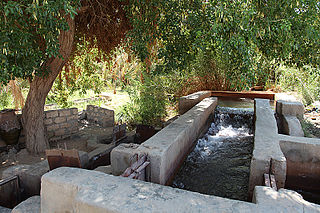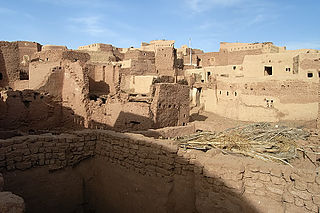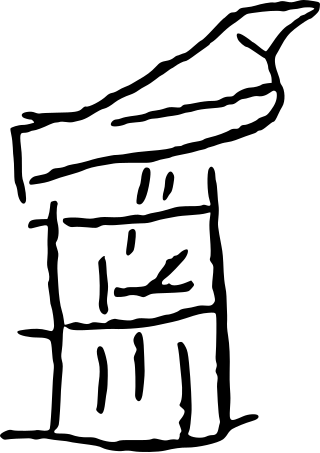
New Valley Governorate or El Wadi El Gedid Governorate is a governorate of Egypt. It is in the southwestern part of the country, in the south of Egypt Western Desert, between the Nile, northern Sudan, and southeastern Libya.

Dakhla Oasis or Dakhleh Oasis, is one of the seven oases of Egypt's Western Desert. Dakhla Oasis lies in the New Valley Governorate, 350 km (220 mi.) from the Nile and between the oases of Farafra and Kharga. It measures approximately 80 km (50 mi) from east to west and 25 km (16 mi) from north to south.

Titkheperure or Tyetkheperre Psusennes II [Greek Ψουσέννης] or Hor-Pasebakhaenniut II [Egyptian ḥr-p3-sb3-ḫˁỉ-⟨n⟩-nỉwt], was the last king of the Twenty-first Dynasty of Egypt.

Friedrich Gerhard Rohlfs was a German geographer, explorer, author and adventurer.

The New Valley Project or Toshka Project consists of building a system of canals to carry water from Lake Nasser to irrigate part of the sandy wastes of the Western Desert of Egypt, which is part of the Sahara Desert.

The Kharga Oasislit. 'the outer'; Coptic: (ϯ)ⲟⲩⲁϩ ⲛ̀ϩⲏⲃ(di)wah enhib, "Oasis of Hib", (ϯ)ⲟⲩⲁϩ ⲙ̀ⲯⲟⲓ(di)wah empsoi "Oasis of Psoi") is the southernmost of Egypt's five western oases. It is located in the Western Desert, about 200 km to the west of the Nile valley. "Kharga" or "El Kharga" is also the name of a major town located in the oasis, the capital of New Valley Governorate. The oasis, which was known as the 'Southern Oasis' to the Ancient Egyptians, the 'outer' to the Greeks and Oasis Magna to the Romans, is the largest of the oases in the Libyan desert of Egypt. It is in a depression about 160 km long and from 20 km to 80 km wide. Its population is 67,700 (2012).

The Theban Triad is a triad of Egyptian gods most popular in the area of Thebes, Egypt.

The Farafra depression is a 980 km2 (380 sq mi) geological depression, the second biggest by size in Western Egypt and the smallest by population, near latitude 27.06° north and longitude 27.97° east. It is in the large Western Desert of Egypt, approximately midway between Dakhla and Bahariya oases.

Usermaatre Setepenamun Takelot III Si-Ese was Osorkon III's eldest son and successor. Takelot III ruled the first five years of his reign in a coregency with his father, according to the evidence from Nile Quay Text No.13, and succeeded his father as king the following year. He served previously as the High Priest of Amun at Thebes. He was previously thought to have ruled Egypt for only 7 years until his 13th Year was found on a stela from Ahmeida in the Dakhla Oasis in 2005.
DAK is an abbreviation for the Afrika Korps, a famed German World War II unit.
Al-Ma'sarah, also spelled Maasarah or Masarah, is a city in Dakhla Oasis, Egypt.

Seheruibre Padibastet better known by his Hellenised name Petubastis III was a native ancient Egyptian ruler, who revolted against Persian rule.
The Dakhla Formation, also called the Dakhla Shale, is a Maastrichtian-Danian geologic formation in the Western Desert, Egypt. Dinosaur remains are among the fossils that have been recovered from the formation, although none have yet been referred to a specific genus.
The Sheikh Muftah culture is attested in the western desert of Egypt and flourished in the 3rd millennium BCE, from about 3200–2000 BCE. They were most likely nomads.

Abu Ballas is an archaeological site in the Libyan Desert of Egypt. It lies about 200 km (120 mi) south-west of the Dakhla Oases and consists of two isolated sandstone cones in the otherwise flat desert. Both hills are covered with Egyptian pottery. These vessels were at the beginning of the 20th century often well preserved, but are today – due to modern tourism – very much destroyed. The site was discovered in 1918 and 1923. More recent research was undertaken in the last years.
Mut or Dakhla, is a city in the New Valley Governorate, Egypt. Its population was estimated at 24,400 people in 2018.

Balat, is a small town in the New Valley Governorate, Egypt. Its population was estimated at 3,700 people in 2006.

Abu Minqar is an oasis town in Qesm Al Wahat Ad Dakhlah District, New Valley Governorate, Egypt, about 93 kilometres (58 mi) by road southwest of Farafra. It is inhabited mainly by Bedouins and lies along a historical caravan route to Kufra, Libya.

A was the name of an Early Dynastic pharaoh of Ancient Egypt. His name is known from a graffito serekh carved into a sandstone outcropping 10 to 12 kilometers south-west of Umm el-Dabadib at the Kharga Oasis in the Western Desert. The presence of the serekh shows evidence of royal activity in the far reaches of the Western Desert as early as the protodynastic period.














